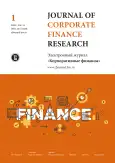Assessment of Measures for Tax Regulation of Transfer Pricing from the Standpoint of National Welfare
- Authors: Polezharova L.1
-
Affiliations:
- Financial University under the Government of the Russian Federation
- Issue: Vol 14, No 1 (2020)
- Pages: 80-90
- Section: Methods
- URL: https://bakhtiniada.ru/2073-0438/article/view/299663
- DOI: https://doi.org/10.17323/j.jcfr.2073-0438.14.1.2020.80-90
- ID: 299663
Cite item
Full Text
Abstract
This article is devoted to development of mathematical models for resolving an actual scientific challenge in the field of corporate finance. This involves substantiating taxation policies for the counter-acting tax planning of multinational companies (MNC), and then devising and articulating the appropriate international taxation scheme, as evaluated from the position of national welfare policy. Based on an analysis of existing models of international taxation, and on the peculiarities of the actual mechanism of capital movement tax regulation, new models with equilibrium postulated have been developed.
The primary mechanisms of this research involve the following considerations: (1) examination of an approach targeted at the determination of the final outcomes of international taxation from the perspective of national economies; (2) measures of tax planning on the part of MNCs, and corresponding counter-acting measures to the tax planning applied by governments, are taken as a complex.
Our results indicate that because a government uses rules of controlled transactions, in order to counter-act MNCs’ tax planning, for the government the final outcome from an application of these rules may be negative. This is due to a possibility of MNCs’ development in convenient and offshore jurisdictions. This finding is illustrated by means of an approbation of models with a case study involving a three-tier structure.
Further to this point, instead of additional revenues, a government is at a risk of a shrinking tax base and a reduction in budget revenues; and moreover from the perspective of national welfare, the additional loss of revenues and capital of MNCs. Therefore there is a significant importance in forming rules for MNC taxation policies which would focus not on taxes as such, but would focus on trying to keep capital within the territory and/or would facilitate the return of earlier divested income. This could be attempted, for example, by using the secondary adjustment rule in conjunction with a minimum tax on return.
The novelty of this research resides in the specificity of our investigation and the applicability of our conclusions to the practical challenges of international taxation and national revenue policies. The peculiarities of this economic moment and the crucial challenges for national governments in dealing with MNCs and the digital economy underline the significance of this study. Our results expand and develop the existing literature in this ever-crucial area be of immediate use to policymakers, academics and administrators involved in national and international taxation, finance, economics, and analysis.
About the authors
L. Polezharova
Financial University under the Government of the Russian Federation
Author for correspondence.
Email: LVPolezharova@fa.ru
ORCID iD: 0000-0002-2636-6567
PhD in Economics, Associate Professor
Russian Federation, MoscowReferences
- World Trade Statistical Review 2017. Geneva: World Trade Organization; 2017. 177 p. URL: https://www.wto.org/english/res_e/statis_e/wts2017_e/wts2017_e.pdf.
- World Investment Report 2017: Investment and the Digital Economy. Geneva: United Nations Conference on Trade and Development; 2017. 237 p. URL: https://unctad.org/en/PublicationsLibrary/wir2017_en.pdf.
- Feldstein M. The international consequences of US tax reform. Project Syndicate. Sept. 27, 2017. URL: https://www.project-syndicate.org/commentary/united-states-tax-reform-international-impact-by-martin-feldstein-2017-09?barrier=accesspaylog.
- Tax Effects on Foreign Direct Investment: Recent Evidence and Policy Analysis. OECD Tax Policy Studies. 2017;(17). URL: https://www.oecd-ilibrary.org/taxation/tax-effects-on-foreign-direct-investment_9789264038387-en.
- BEPS Action 1: Address the Tax Challenges of the Digital Economy. 24 March 2014 – 14 April 2014. Public Discussion Draft. Paris: OECD; 2014. 81 p. URL: https://www.oecd.org/ctp/tax-challenges-digital-economy-discussion-draft-march-2014.pdf.
- Addressing the Tax Challenges of the Digital Economy. Action 1: 2015 Final Report. OECD/G20 Base Erosion and Profit Shifting Project. Paris: OECD Publ.; 2015. 285 p. doi: 10.1787/9789264241046-en.
- Addressing Base Erosion and Profit Shifting. Paris: OECD Publ.; 2013. 91 p. doi: 10.1787/9789264192744-en.
- Haufler A., Mardan M., Schindler D. An economic rationale for controlled-foreign-corporation rules. In: Annual Conference: Evidence-Based Economic Policy. Hamburg: Association for Social Policy; 2014. URL: https://www.econstor.eu/bitstream/10419/100405/1/VfS_2014_pid_973.pdf.
- Grubert H. The tax burden on cross-border investment: company strategies and country responses. CESIFO Working Paper. 2003;(964). URL: https://www.ifo.de/DocDL/cesifo_wp964.pdf.
- Whalley J. Puzzles over international taxation of cross border flows of capital income. NBER Working Paper. 2001;(8662). URL: https://www.nber.org/papers/w8662.pdf.
- Vishnevskii V., Grechishkin A. Effects of taxation scheme upon capital migration. Mirovaya ekonomika i mezhdunarodnye otnosheniya = World Economy and International Relations. 2002;(12):18–24. (In Russ.).
- Sutyrin S. F., Pogorletskii A. I. Taxes and tax planning in the global economy. St. Petersburg: V. A. Mikhailov Publ.; Polius; 1998. 577 p. (In Russ.).
- Harry Grubert, in memoriam. National Tax Association. 2013. URL: https://www.ntanet.org/fpstory/2017/08/harry-grubert-in-memoriam/ (accessed on 31.01.2019).
- Jorgenson D. Capital theory and investment behaviour. The American Economic Review. 1963;53(2):247–259.
- OECD Transfer Pricing Guidelines for Multinational Enterprises and Tax Administrations. Paris: OECD Publ.; 2010. 371 p. URL: https://read.oecd-ilibrary.org/taxation/oecd-transfer-pricing-guidelines-for-multinational-enterprises-and-tax-administrations-2010_tpg-2010-en#page1.
- Transfer Pricing: Secondary Adjustments. HMRC Consultation. London: Ernst & Young LLP; 2016. 2 p.
- Paying Taxes 2016. London: PWC; World Bank Group; 2015. 144 p. URL: https://www.pwc.com/gx/en/paying-taxes-2016/paying-taxes-2016.pdf.
- Lipatova I. V., Polezharova L. V. International tax planning methodology and best practices of Russian economy deoffshorization. Asian Social Science. 2015;11(19):316–328. doi: 10.5539/ass.v11n19p316.
- Vernon R. In the Hurricane’s Eye: The Troubled Prospects of Multinational Enterprises. Cambridge, MA, London: Harvard University Press; 1998. 288 p.
- Krasnov I. Transfer pricing and international taxation practices of multinational corporations. Upravlenie ekonomicheskimi sistemami: elektronnyi nauchnyi zhurnal = Management of Economic Systems: Scientific Electronic Journal. 2013;(5):11. URL: http://www.uecs.ru/otraslevaya-ekonomika/item/2134-2013-05-13-06-54-04. (In Russ.).
- Célestin L. C. The formulary approach to the taxation of transnational corporation: a realistic alternative? PhD thesis. Synopsis. 2000. URL: https://ses.library.usyd.edu.au/bitstream/handle/2123/846/adt-NU20020917.13313801front.pdf?sequence=1&isAllowed=y.
- Bhat G. Transfer pricing, tax havens and global governance. Deutsches Institut für Entwicklungspolitik. Discussion Paper. 2009;(7). URL: https://www.files.ethz.ch/isn/102933/2009-07e.pdf.
- Commission proposes major corporate tax reform for the EU. Press release. Strasbourg: European Commission; Oct. 25, 2016. URL: https://ec.europa.eu/commission/presscorner/detail/en/IP_16_3471.
Supplementary files










